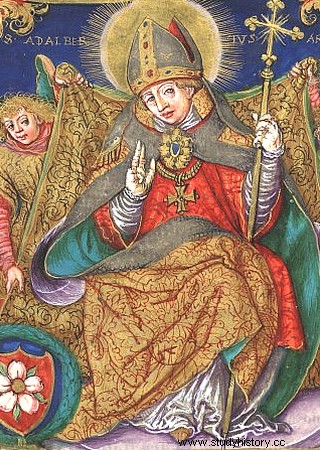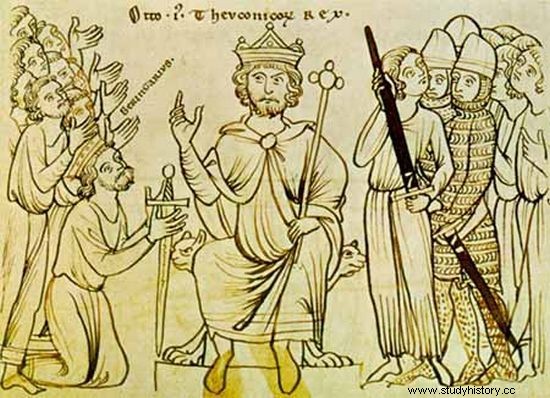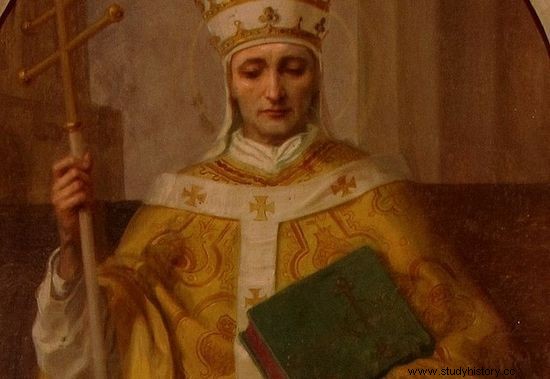In the "Polish" report from the famous Gniezno congress, Gall Anonim mentioned above all the extraordinary wealth of Bolesław the Brave and the honor that befell him on the part of the German emperor, Otto III. The Germans remembered the events of the thousandth year somewhat differently. Bishop-chronicler Thietmar noted:When Otto saw the longed-for stronghold from afar, he approached it barefoot with the words of prayer on his lips (Rev. IV, 45). How is it even possible that the supreme ruler of Europe went barefoot to the Polish capital?
Our native textbooks explain this event in two ways. First of all, Bolesław the Brave was a sly politician and knew how to wrap a young emperor around his finger. He bought the body of Bishop Wojciech murdered by the Prussians, brought it to Gniezno and used it accordingly.
To Saint only barefoot
Otto III was going to the relics of the martyr (and not - God forbid - to our good-natured Bolesław!) Barefoot, with tears, or perhaps in a hair shirt. It's hard to disagree with this explanation.

Saint Adalbert, Otto III made a pilgrimage to his grave.
Secondly, historians emphasize that Otto III was generally a very unusual ruler who, even for the realities of the early Middle Ages, attached excessive importance to asceticism, penance or religious reflection.
In a word, he was a kind of a freak emperor and thus marched barefoot to the town of Polans. How much truth is there in that? Very little.
Otto III was indeed an extravagant ruler, but in this particular case he followed the tradition that had been popular for several decades which was perfectly understandable to his entourage and subjects. If anyone was surprised by the "penitential" behavior of the emperor, it was only Polan.
Anyway, one could not expect Bolesław's courtiers and squadrons to keep up with the Western European religious "fashion". Even more so, the 10th century customs are not understandable to people living in the 21st century.
Fortunately, the German medievalist Gerd Althoff and his innovative book "The Power of Ritual" come to the rescue. This insightful historian recreated a peculiar ritual that gained popularity among German rulers and bishops in the 10th-11th centuries.

Walking barefoot was not a priority for the German rulers. Otton I already practiced them.
Let's start with the quote. As Althoff writes, the era of the Ottonian dynasty was a time when rulers often expressively demeaned themselves, which in the understanding of contemporaries meant exaltation (...). The penitential robes and gestures of the rulers expressed exactly what was formulated as the ethical foundations of their office (pp. 102, 104).
Reason of state requires the emperor to go barefoot
In short: asceticism and penance were in good taste and this is what the subjects expected of the emperor! To show their piety and moral superiority over the masses, the rulers decided to make various gestures, but most often ... they walked barefoot.
Already grandfather of Otto III, Otto I, according to Biskupia Chronicle from Halberstadt reconciled with the local bishop by putting on the pose of a penitent, going barefoot to the bishop and prostrating himself in front of him. Footwear was also shed by Otto III's close associates and mentors - Bishop Wojciech from Prague or Heribert from Cologne. Both, taking office, went to their bishopric barefoot and in penitential robes (p. 102).
Half a century later, the newly elected Pope Leo IX did the same. The following rulers, after Otto III, behaved in a similar way:both those considered particularly pious and exceptionally secular. Henry II despite severe cold carried the relics of St. Maurice from the Berge monastery to the cathedral (p. 104).
Henry III, reigning a little later, decided on an act of penance (or maybe humility?) After ... a victorious battle with Hungary. As Gerd Althoff writes, the king threw himself barefoot and in his hair shirt in front of the relics of the holy cross to the ground (p. 107). He did the same at his mother's funeral. Similar examples can be multiplied:in a word, what Otto III did was not surprising .

Not only secular rulers but also bishops and popes walked barefoot. Leo IX was no exception.
The peculiar tradition of emperors ostentatiously walking barefoot and throwing themselves in the face did not last long. Everything changed after, in 1077, the humiliated German ruler Henry IV humbled himself to the Pope in Kanossa (standing for three days barefoot in the courtyard!). Then this ritual took on new meanings and almost no German king or emperor was willing to take his shoes off his feet:neither in front of the bishop, nor the pope, or even God.
Source:
Trivia is the essence of our website. Short materials devoted to interesting anecdotes, surprising details from the past, strange news from the old press. Reading that will take you no more than 3 minutes, based on single sources. This particular material is based on:
- Gerd Althoff, The Power of Ritual. Symbolism of power in the Middle Ages, Polish Scientific Publishers PWN 2011.
